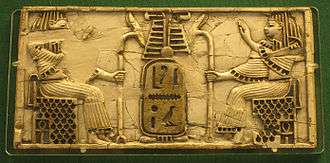Folded cloth (s hieroglyph)
| ||
| Folded Cloth (vertical s ) in hieroglyphs |
|---|
| Wikimedia Commons has media related to Cloth folded (s hieroglyph). |
| Wikimedia Commons has media related to Seat-back, folded cover. |
The Ancient Egyptian folded cloth hieroglyph is Gardiner sign listed no. S29 for a type of cushioning, a seat-backing.
The folded cloth hieroglyph is used in the Ancient Egyptian language hieroglyphs for the alphabetic consonant letter (vertical)—s.[1]
Origin of folded cloth as seat cushion

The Nimrud Ivories have an Ancient Egyptian example with a central theme cartouche and confronted seated dignitaries-(gods or pharaohs). The was sceptre, (authority), is held in each hand. The ankh symbol, life-giving, is at the base of each seat.
The cartouche contains the horizontal n hieroglyph, a foot (hieroglyph), the quail chick (hieroglyph), (=u, or w), and the sun (hieroglyph), symbolizing Ra; also a vertical stroke (hieroglyph), accentuating Ra, and the vertical reed hieroglyph.
The cartouche is surmounted on top with the shuti, twin feather adornment, often also found on headresses.
The Egyptian hieroglyph alphabetic letters
The following two tables show the Egyptian uniliteral signs. (24 letters, but multiple use hieroglyphs)
a
|
i
|
y
|
'
|
(w,u)
|
B
| |||||||||||||
P
|
F
|
M
|
N
|
R
|
H1
| |||||||||||||
H2
|
Kh1
|
Kh2
|
S
|
(Sh)=Š
|
Q/K2
| |||||||||||||
K
|
G
|
T
|
Ch—Tj
|
D
|
Dj
| |||||||||||||
| L/(R) (special) (Ptolemaic, etc.)
|
-- | -- | -- | -- | -- |
| a | i (ee) |
y ii |
' ah, (aïn) |
w, (u) (oo) |
B | |||||||||||||||||
| P | F | M | N | R | H1 | |||||||||||||||||
| H2 | (Kh)1 | (Kh)2 | S | Sh (Sh) |
K emphatic | |||||||||||||||||
| K | G | T | Tj Ch Tsh |
D | Dj | |||||||||||||||||
| (additionally 4 for vert/horiz) |
-- | -- | -- | -- | -- | |||||||||||||||||
M (horiz) M2-Plinth |
N (vert) (see: N (red crown)) |
S (vert) S (folded) cloth) |
M (3rd-M -2nd-vert) M3-Baker's tool (vertical) | |||||||||||||||||||
| (additionally 3 for equivalents) |
-- | -- | -- | -- | -- | |||||||||||||||||
is—
y2-Two strokes |
is—
letter w, u (see w2-Coil) |
T (no. 2) T2-Pestle |
-

White seat-backing (S hieroglyph)
-

Red seat back
See also
References
- ↑ Schumann-Antelme, and Rossini, 1998. Illustrated Hieroglyphics Handbook, uniliteral: U20, p. 56-57.
- Schumann-Antelme, and Rossini, 1998. Illustrated Hieroglyphics Handbook, Ruth Schumann-Antelme, and Stéphane Rossini. c 1998, English trans. 2002, Sterling Publishing Co. (Index, Summary lists (tables), selected uniliterals, biliterals, and triliterals.) (softcover, ISBN 1-4027-0025-3)